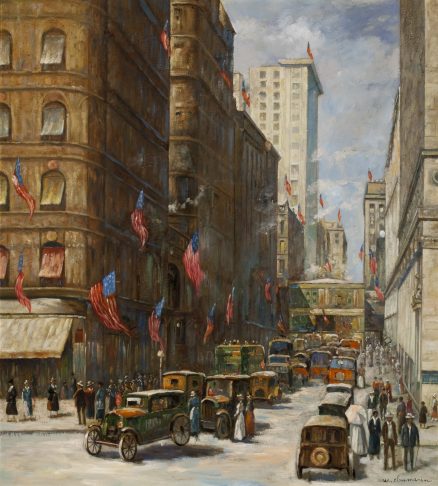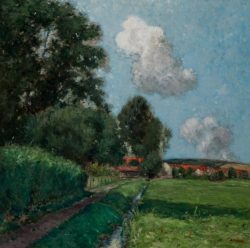Untitled (Chicago Street Scene)
, circa 1920sOil on canvas, 40 by 30 inches
- Categories
- Chicago places & people
- Landscapes
- Zoom in on Artwork
- Print Page
- Email Page to Friend
William Clusmann’s painting offers a view in Chicago’s “Loop” looking west along Adams Street from Michigan Avenue. On the left looms the hulking brick-and-granite Pullman Building, designed in 1884 by Solon S. Beman to house the offices of the sleeping-car company (it was demolished in the 1950s). The lighter terra-cotta-clad People’s Gas Building, the work of architect Daniel Burnham in 1910, faces it on the north side of Adams. The vista is blocked by the station for the elevated train line over Wabash Avenue and at street level by choking automobile traffic. Pedestrians fill the sidewalks, some waiting to cross the avenue toward the Art Institute of Chicago, from whose steps this slightly elevated view is taken. The building facades, particularly the ponderous bulk of the Pullman, are enlivened by numerous flags, suggesting a Memorial Day or Fourth of July observance; the light-colored hats worn by several figures and the parasol sheltering a woman at the lower right hint at summertime warmth.
When Clusmann began painting the city, soon after the turn of the twentieth century, he typically softened and screened the polluted industrial Chicago River in tones faithful to its notoriously smoke-darkened atmosphere. Within a few years, however, he came under the spell of the strong light and higher-keyed colors of impressionism as he shifted his focus to the city’s streets and parks. In the central business district, the construction of such imposing buildings at those depicted here inspired civic pride among Chicago’s citizens and drew the attention of many of the city’s artists. Between about 1913 and the mid-1920s, Clusmann painted several views of Michigan Avenue and its environs that celebrate the avenue as the city’s new emblem of modern sophistication. One of two almost identical, undated views taken from the same vantage point, this painting is typical of Clusmann’s upbeat presentation of his hometown as a bustling metropolis of ordered prosperity. It reflects a newly positive self-image, particularly for the city’s lakefront, that began to emerge with the expectations raised by the publication of Burnham’s Plan of Chicago of 1909.
Wendy Greenhouse, PhD

